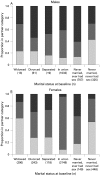Role of widows in the heterosexual transmission of HIV in Manicaland, Zimbabwe, 1998-2003
- PMID: 19307340
- PMCID: PMC2654148
- DOI: 10.1136/sti.2008.033043
Role of widows in the heterosexual transmission of HIV in Manicaland, Zimbabwe, 1998-2003
Abstract
Background: AIDS is the main driver of young widowhood in southern Africa.
Methods: The demographic characteristics of widows, their reported risk behaviours and the prevalence of HIV were examined by analysing a longitudinal population-based cohort of men and women aged 15-54 years in Manicaland, eastern Zimbabwe. The results from statistical analyses were used to construct a mathematical simulation model with the aim of estimating the contribution of widow behaviour to heterosexual HIV transmission.
Results: 413 (11.4%) sexually experienced women and 31 (1.2%) sexually experienced men were reported to be widowed at the time of follow-up. The prevalence of HIV was exceptionally high among both widows (61%) and widowers (male widows) (54%). Widows were more likely to have high rates of partner change and engage in a pattern of transactional sex than married women. Widowers took partners who were a median of 10 years younger than themselves. Mathematical model simulations of different scenarios of sexual behaviour of widows suggested that the sexual activity of widow(er)s may underlie 8-17% of new HIV infections over a 20-year period.
Conclusions: This combined statistical analysis and model simulation suggest that widowhood plays an important role in the transmission of HIV in this rural Zimbabwean population. High-risk partnerships may be formed when widowed men and women reconnect to the sexual network.
Conflict of interest statement
Figures




References
-
- World Health Organization Global burden of disease Geneva: World Health Organization, 2002
-
- Adeokun LA, Nalwadda RM. Serial marriages and AIDS in Masaka District. Health Transit Rev 1997;7Suppl:49–66 - PubMed
-
- Carpenter LM, Kamali A, Ruberantwari A, et al. Rates of HIV-1 transmission within marriage in rural Uganda in relation to the HIV sero-status of the partners. AIDS 1999;13:1083–9 - PubMed
-
- Palloni A, Lee YJ. Some aspects of the social context of HIV and its effects on women, children and families. Popul Bull UN 1992;(33):64–87 - PubMed
-
- US Census Bureau. International database. 2005. http://www.census.gov/ipc/www/idb.
Publication types
MeSH terms
Grants and funding
LinkOut - more resources
Full Text Sources
Medical
